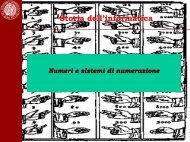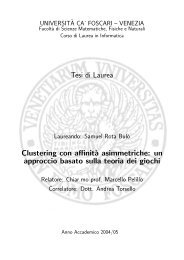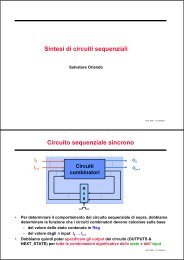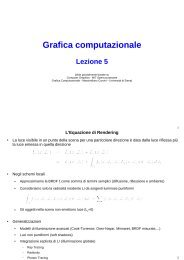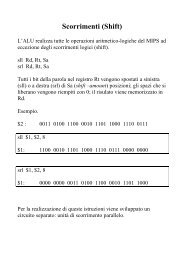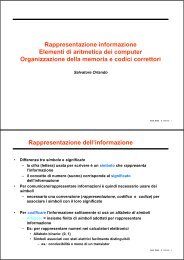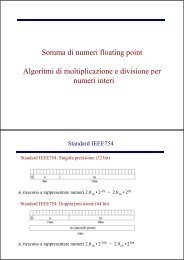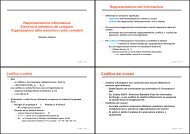Dispensa in PDF - Dipartimento di Scienze Ambientali, Informatica e ...
Dispensa in PDF - Dipartimento di Scienze Ambientali, Informatica e ...
Dispensa in PDF - Dipartimento di Scienze Ambientali, Informatica e ...
You also want an ePaper? Increase the reach of your titles
YUMPU automatically turns print PDFs into web optimized ePapers that Google loves.
Carnielli Efrem: Programmazione a componenti<br />
Client/server <strong>in</strong> dettaglio<br />
simultaneamente ecco che quest'ultima soluzione risulta la migliore.<br />
Qui entra <strong>in</strong> gioco l’ access server visualizzato <strong>in</strong> figura2.46. L’access server a scapito<br />
del nome è una grossa macch<strong>in</strong>a client dove si <strong>in</strong>stanziano tanti processi (client)<br />
quante sono le precedenti macch<strong>in</strong>e client obsolete. L’output grafico viene <strong>in</strong>viato<br />
da un re<strong>di</strong>rector ad un server X che si trova nelle postazioni <strong>di</strong> lavoro (a questo<br />
punto non parliamo più <strong>di</strong> client). L'access server perciò è formato da una serie <strong>di</strong><br />
istanze <strong>di</strong> client e processi filtro (i re<strong>di</strong>rector). Viene chiamato erroneamente server<br />
<strong>in</strong> quanto offre un servizio. Il nome access server, <strong>in</strong>fatti, deriva dal fatto che è un<br />
server <strong>di</strong> “accesso all’applicazione”.<br />
Server X<br />
Server X<br />
Server X<br />
Server X<br />
ACCESS SERVER<br />
re<strong>di</strong>rector<br />
re<strong>di</strong>rector<br />
re<strong>di</strong>rector<br />
re<strong>di</strong>rector<br />
Server<br />
Figura 2.17. L’access server come <strong>in</strong>sieme <strong>di</strong> processi client e re<strong>di</strong>rector.<br />
L’access server può essere utilizzato anche come firewall (ve<strong>di</strong> appen<strong>di</strong>ce): non si<br />
usa per mantenere operative le vecchie macch<strong>in</strong>e ma a scopi <strong>di</strong> sicurezza. In questo<br />
modo, ad esempio, la parte client dell’applicazione aziendale rimane all’<strong>in</strong>terno<br />
della lan (ve<strong>di</strong> appen<strong>di</strong>ce) ma l’applicazione può essere usata anche fuori <strong>in</strong> tutta<br />
sicurezza. Si veda l’esempio <strong>in</strong> figura 2.14.<br />
C<br />
C<br />
C<br />
C<br />
Client<br />
Client<br />
Client<br />
Client<br />
41





